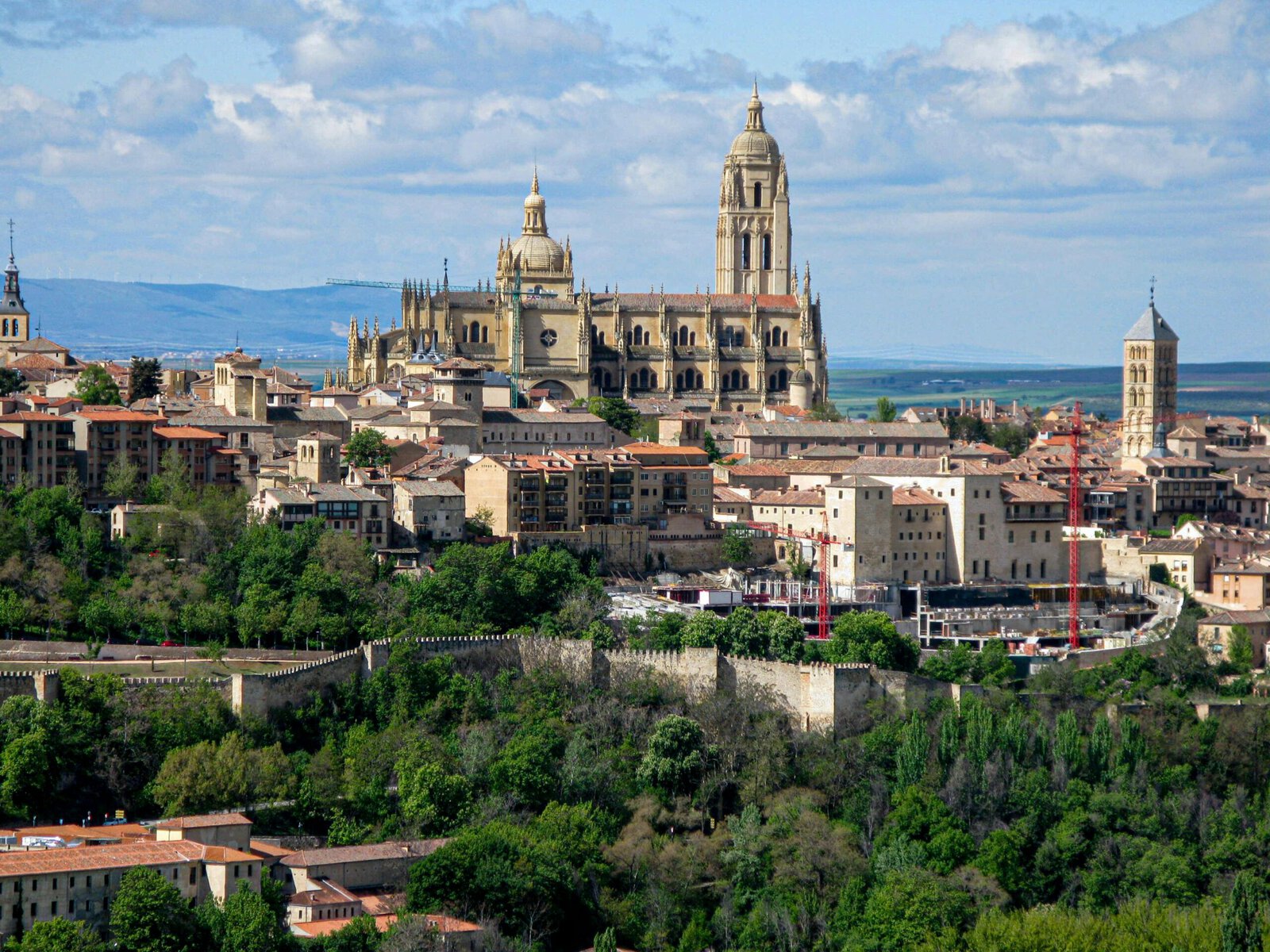
Best Things To See & Do In Segovia
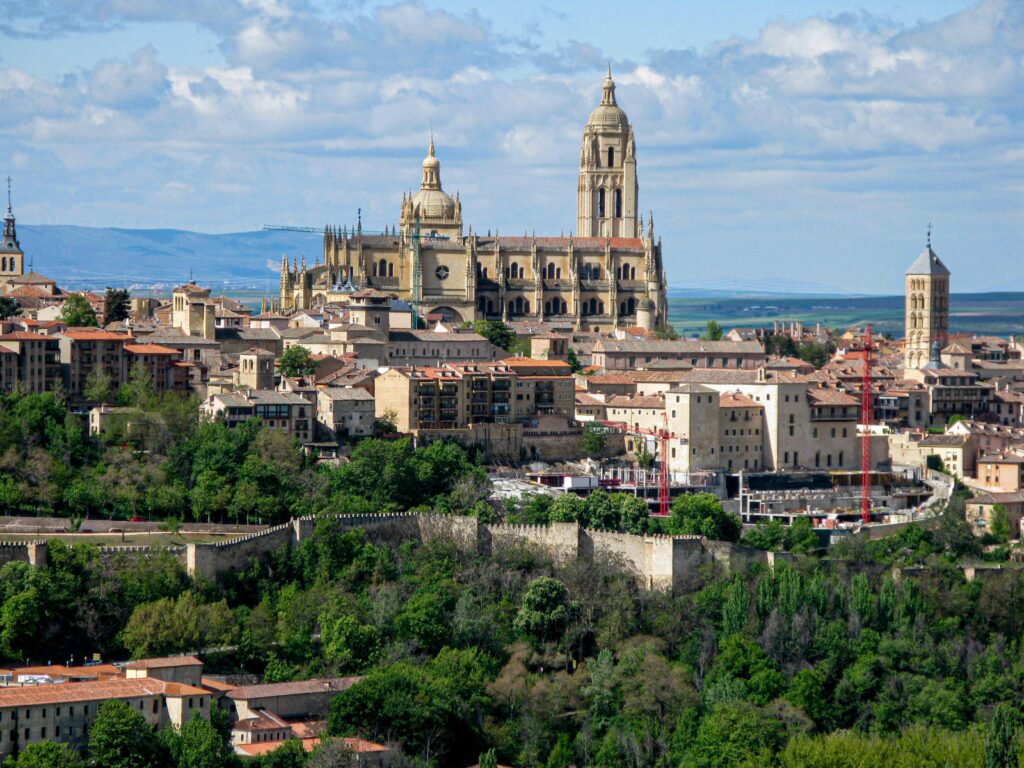
Segovia, a UNESCO World Heritage Site, is a city steeped in history, culture, and architectural splendour. Located in the Castile and León region of Spain, approximately 90 kilometres from Madrid, it boasts a remarkable blend of Roman, medieval, and Renaissance influences. In this blog, I’ve pulled together a comprehensive list of the best things to see and do in Segovia.
Why Visit Segovia
Segovia is like stepping into a real-life fairy tale! This UNESCO World Heritage Site is a treasure trove of history and charm. You’ll be amazed by the Roman Aqueduct, a nearly 2,000-year-old masterpiece that’s still standing strong in the heart of the city.
Then there’s the Alcázar of Segovia, perched majestically on a rocky hilltop, a fairytale-like castle steeped in medieval history. On the other hand, the Segovia Cathedral, with its intricate Gothic design, offers a serene yet awe-inspiring experience.
Beyond its iconic landmarks, Segovia’s narrow, cobblestone streets lead you through a harmonious blend of Roman, Moorish, and Castilian influences. The city’s food scene is a must-try! The cochinillo asado (roast suckling pig) is incredible. It’s a taste of pure Spanish culture.
I genuinely recommend visiting Segovia. It’s an impressive place to spend time in, and I’m sure you’ll absolutely love it!
A Short History of Segovia
Segovia’s history stretches back to ancient times, with evidence of a Celtic settlement predating the Roman conquest. However, the city truly rose to prominence during the Roman era, when it became an important administrative and military centre. The most enduring legacy from this period is the stunning Roman Aqueduct, built around the 1st century AD to supply water from the Frío River to the city. After the decline of the Roman Empire, Segovia fell under Visigoth and later Moorish control before being recaptured by Christian kingdoms during the Reconquista in the 11th century.
During the medieval period, Segovia experienced significant growth, both economically and politically. It became a key site for wool production, which boosted its wealth and influence in Castile. The construction of the Alcázar began in the 12th century, and the fortress evolved into a royal palace, playing a critical role in Spanish history.
The city continued to flourish during the Renaissance, marked by the construction of the grand Segovia Cathedral in the 16th century. This period left an indelible mark on the city’s architectural landscape, blending Romanesque, Gothic, and Mudéjar influences.
Today, Segovia stands as a living monument to its layered history, with its remarkable landmarks and historic streets preserving the spirit of the many eras that have shaped it.
So, now let’s move on to the exciting part; all the best things to see and do in Segovia…
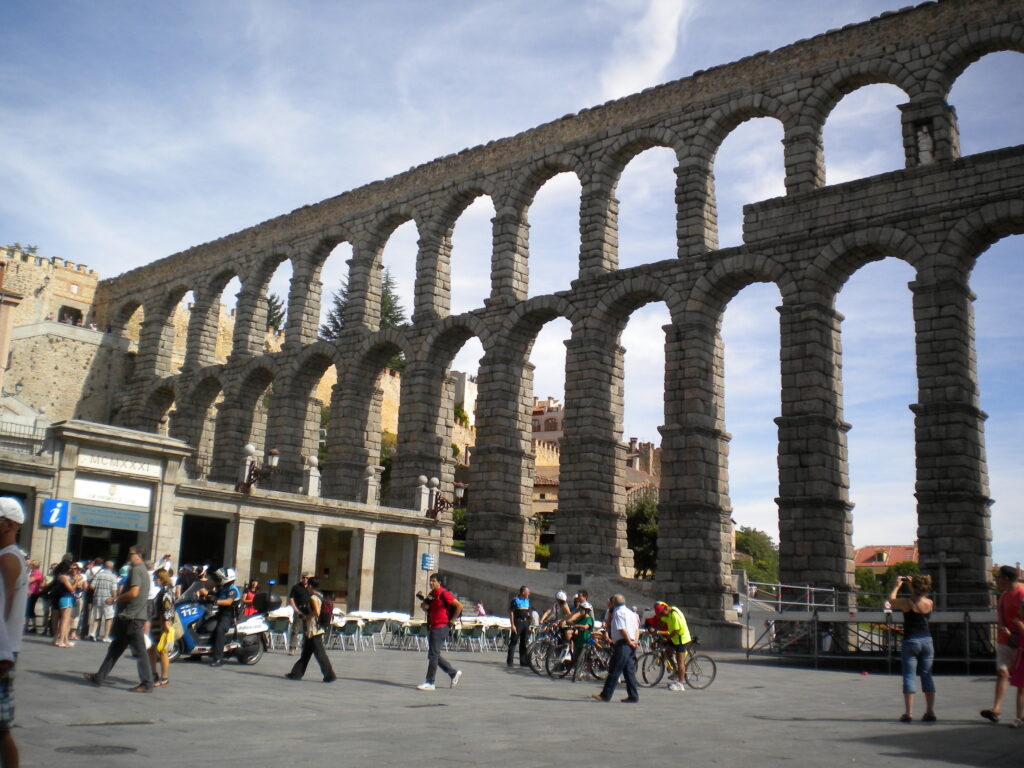
Walk Beneath The Magnificent Roman Aqueduct
The Roman Aqueduct is arguably Segovia’s most famous landmark and a marvel of ancient engineering. Measuring 813 metres in length and standing 28 metres high at its tallest point. This aqueduct is constructed entirely without mortar, a testament to the precision of Roman craftsmanship.
Begin your visit at Azoguejo Square, where the aqueduct is at its most impressive, and enjoy the view as its arches stretch across the city. Walk along the base to appreciate its grandeur from multiple perspectives, and don’t miss the interpretive plaques nearby to learn more about how it operated.
Beyond the Plaza del Azoguejo, there are other superb spots to appreciate the aqueduct’s magnificence. Climb up to the viewing terrace near the Postigo del Consuelo for a breathtaking panorama of the aqueduct. This vantage point also offers stunning photographic opportunities.
Another part of the Aqueduct worth visiting can be found along Calle Cervantes. Here you can get a closer look to really appreciate the precision of the stonework and the sheer scale of the structure.
One final point to mention, as the Aqueduct is an open public monument, you can enjoy its impressive architecture at any time of the day.
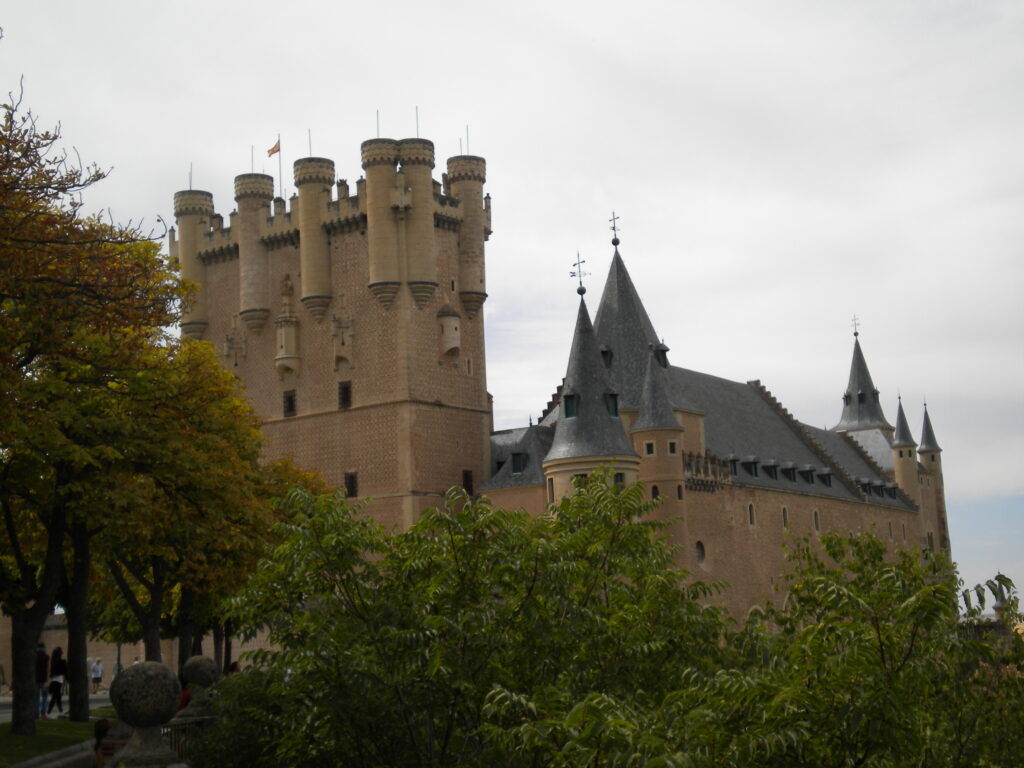
Explore The Fairytale Alcázar of Segovia
Perched on a rocky hilltop at the confluence of two rivers, the Alcázar of Segovia is one of Spain’s most famous castles. Dating back to at least the 12th century, the Alcázar has been a royal palace, state prison, and military academy.
Inside, you can explore lavishly decorated rooms such as the Throne Room, the Hall of the Kings, and the Royal Chamber, each filled with historical artefacts and stunning architecture. The Tower of Juan II offers panoramic views of Segovia and the surrounding countryside. Though it requires a climb of 152 step, it really is worth it.
Location & Opening Hours: The Alcázar is centrally located and very accessible. From the Plaza Mayor or Cathedral, it is about a 15 mins walk and well signposted. If you prefer public transport, local buses are also an easy option. However, walking really is the best way, as you can soak up the atmospheric streets leading to the castle. The Alcázar is open daily, with winter hours (Nov-Mar) from 10am-6pm and longer summer hours (Apr-Oct) from 10am-8pm. There is an entrance fee and tickets can be purchased at the reception (and online in advance).
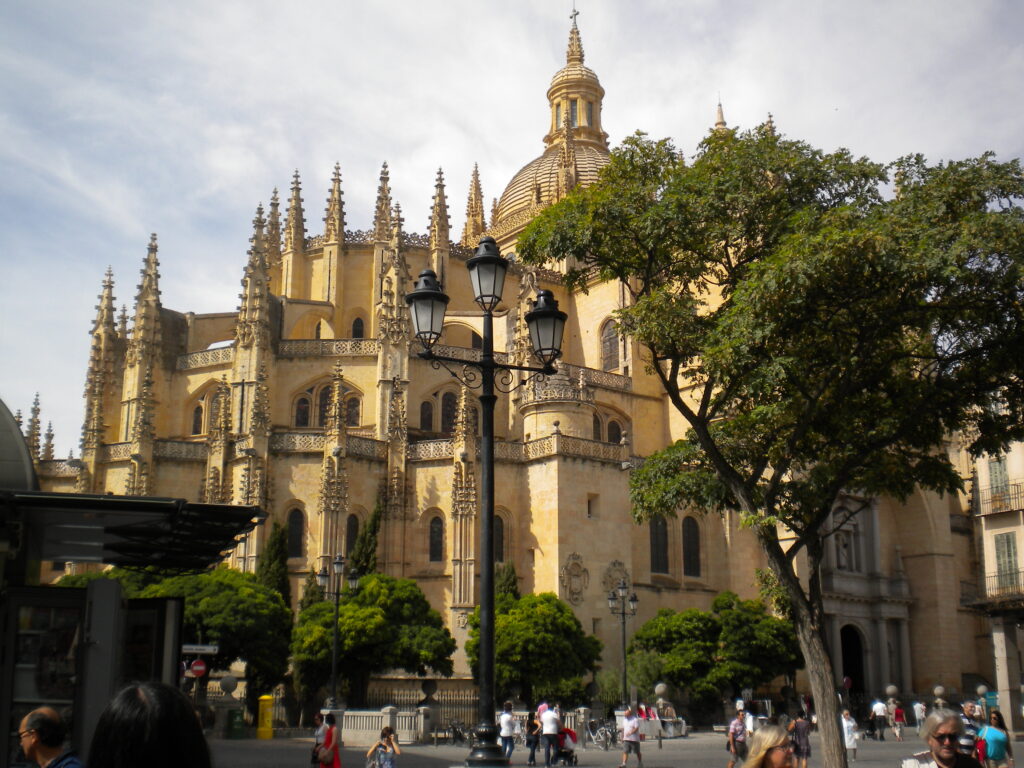
Visit The Grand Segovia Cathedral
The Segovia Cathedral dominates the city’s skyline with its stunning Gothic spires. Constructed between 1525 and 1577, it was one of the last Gothic cathedrals built in Europe.
Inside, the cathedral you will find beautiful chapels, stained-glass windows and a stunning altarpiece in the main chapel. It is also worth climbing the bell tower for great views of the city.
Location & Opening Hours: The Cathedral is located next to the Plaza Mayor. In the winter months (Nov-Mar), opening hours are from 9:30am-6:30pm. During the warmer months (Apr-Oct) the cathedral extends its hours, from 9am-9:30pm. There is an entrance fee and tickets can be purchased at the reception.
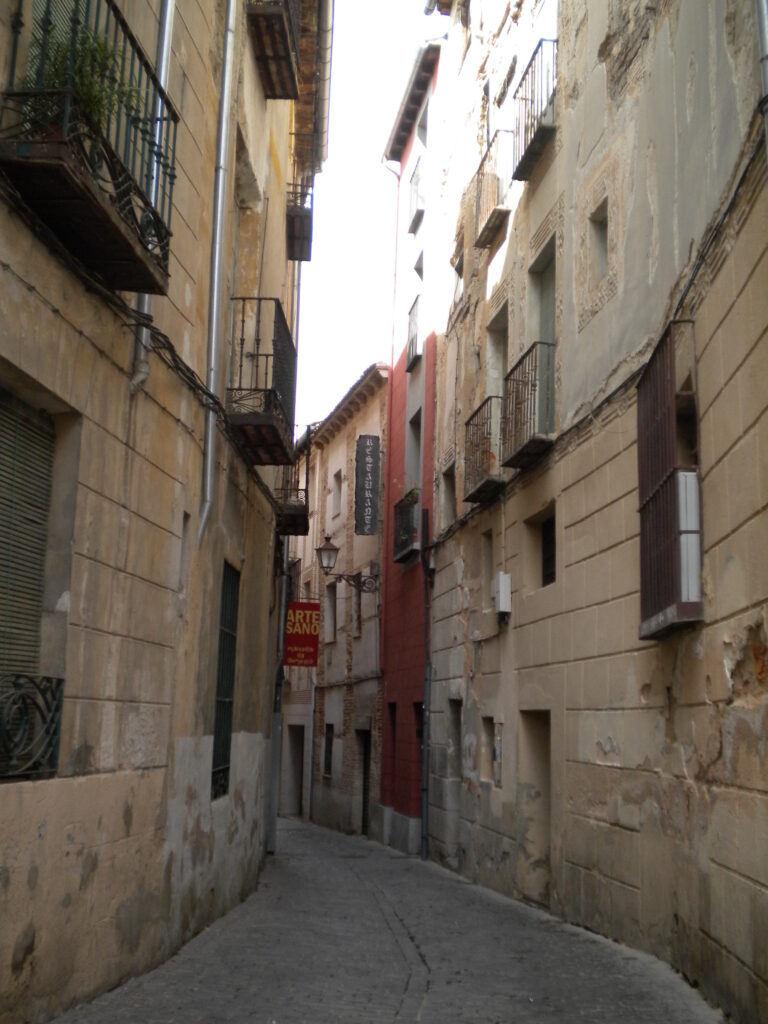
Stroll Through The Jewish Quarter
The Jewish Quarter is located near the city’s historic centre. To find it, head to the Plaza Mayor, the city’s main square, and take Calle Marqués del Arco, which leads directly to the Quarter.
Back in the Middle Ages, this place was a hub for Jewish culture. It really is worth taking a leisurely walk through its streets to enjoy some great architecture and charming spaces.
If you’re interested in learning more about the Jewish community in Segovia, then visit the Centro Didáctico de la Judería. Located on Calle La Judería Vieja 12, it serves as an educational centre dedicated to showcasing the history of the Jews in Segovia. The centre is open daily (typically 10am-2pm) although it’s advisable to check beforehand due to special events.
Also, another attraction worth visiting here is the Corpus Christi Church. This building served as a synagogue until 1410. After this, it was converted into a Catholic church and became part of a convent. This site is significant for both Christian and Jewish communities, reflecting its diverse historical roles; and another worthwhile stop.
The Corpus Christi Church is open daily from around 10am-7pm, however again always check in advance for the latest opening time information. There is a small entrance fee, and tickets can be purchased at the reception.
All in all, the Jewish quarter is a perfect area for a relaxed wander and discovering these small historical gems and local shops.
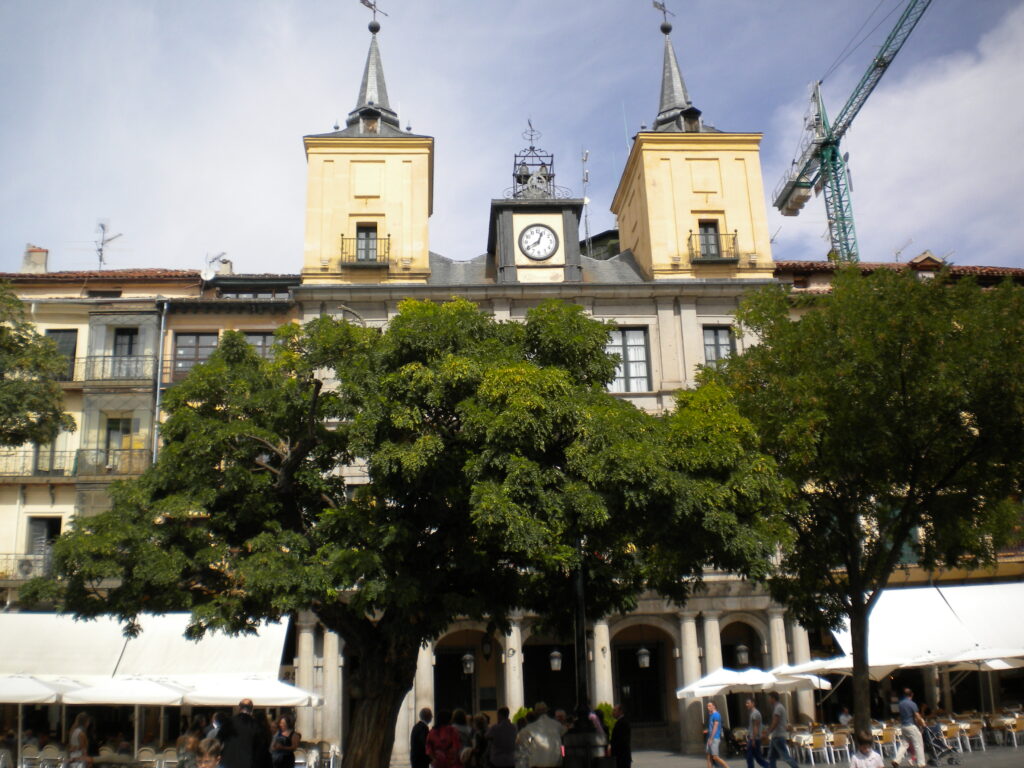
Enjoy The Plaza Mayor
Plaza Mayor is the historic town square located at the end of Calle Real, one of the city’s most renowned streets. This central plaza is a hub of cultural and social activity, surrounded by landmarks that define the city’s architectural and historical identity. Among these are the town hall, the Juan Bravo Theatre, the San Miguel Church, and the Cathedral.
The origins of Plaza Mayor date back to medieval times when it served as the centre for social gatherings and trade. It officially became the city’s main square in the 17th century, becoming the heart of political and economic life in the city. The town hall, constructed during this period, continues to remain a focal point for civic events. The plaza also hosts a weekly market every Thursday (9am-2pm)where you can browse and purchase local goods, crafts, and produce.
The best thing about the Plaza Mayor is that it is lined with cafes and restaurants. Here you can enjoy a leisurely meal or refreshments while taking in the vibrant atmosphere.
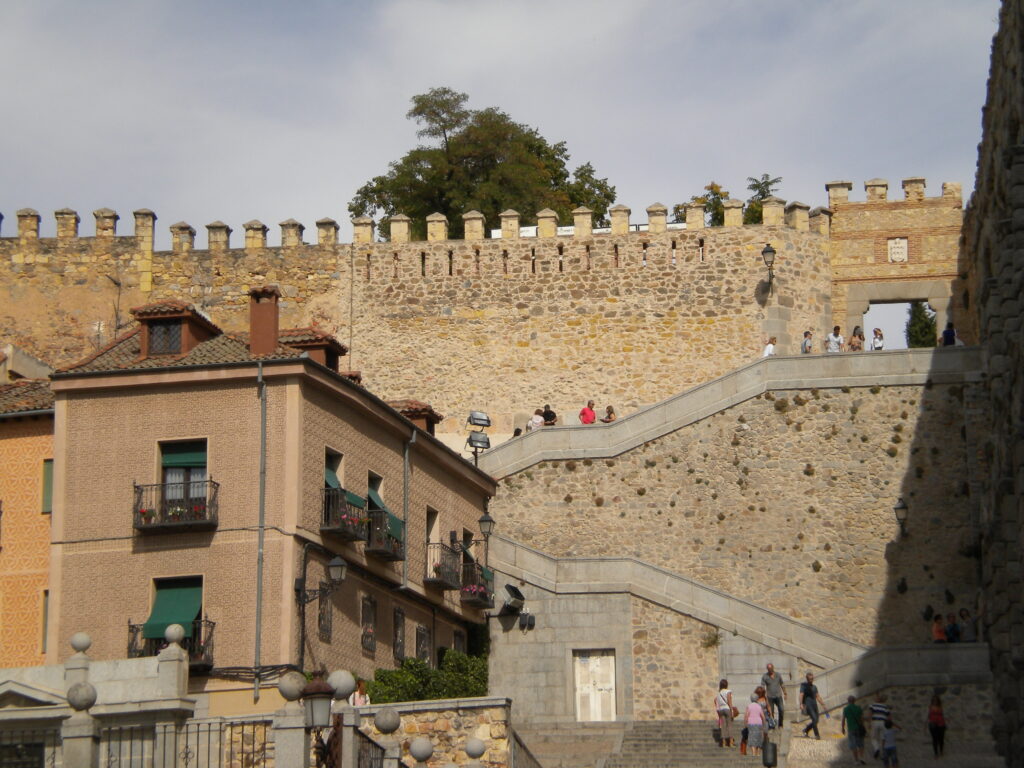
Walk The City Walls & Visit San Andrés Gate
Segovia’s ancient city walls, constructed in the 11th century, stretching nearly 3 kilometres. These walls once surrounded and protected the entire old city. Today you can explore sections of the walls through specific entry points. The main one is at the Visitor Centre located near the San Andrés Gate.
The San Andrés Gate is one of the main entrances into the walled city part of Segovia. It is one of three remaining gates , of the original seven, that guarded Segovia. This gate is situated at the southern end of the wall. The other gates that can be seen include the San Cebrián Gate, located in the northern part and Santiago Gate, which stands to the west. While the San Andrés Gate is open to the public, the other two gates remain closed.
You can visit the city walls by purchasing a ticket at the Visitor Centre. The walls are typically open from 10am-7pm, but check opening hours in advance as they can vary depending on the time of year and special events.
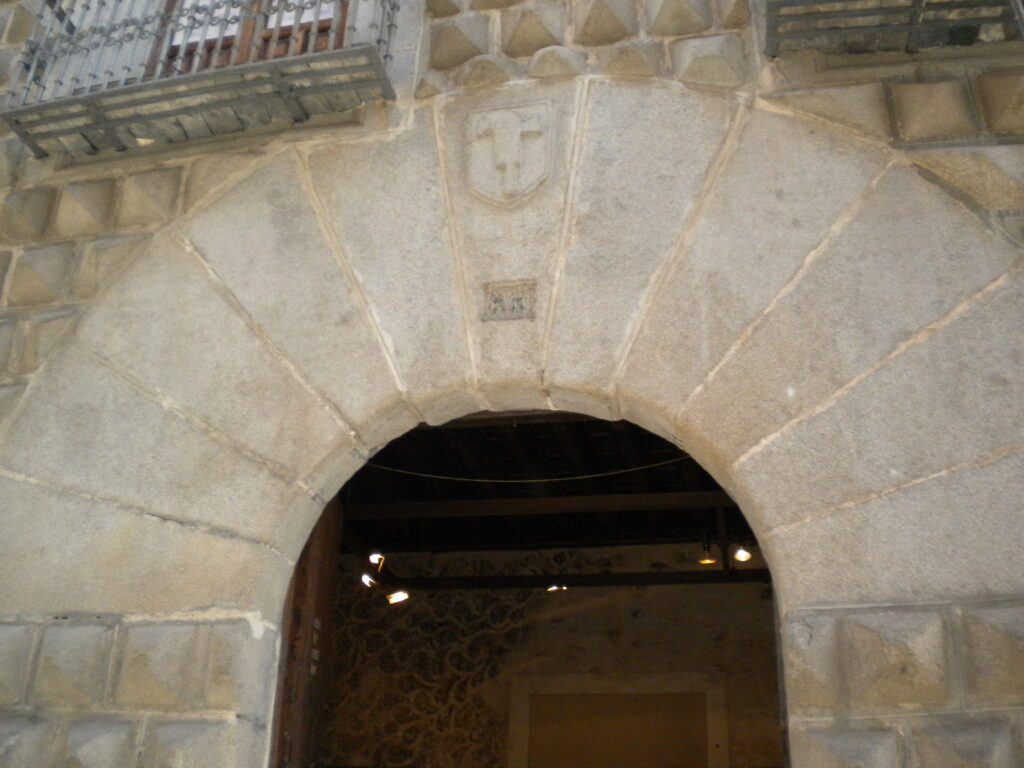
Stop By At Casa De Los Picos
Casa de los Picos, located in the historic centre, on Calle Juan Bravo, is a Renaissance mansion known for its unique facade adorned with 617 pyramid-shaped granite peaks. Built in the 15th century, this architectural feature makes it one of the most recognisable buildings in the city.
Today, the building is the Segovia Art School and serves as an exhibition hall. While the building itself is not a traditional museum, its interior, including the courtyard is accessible during public exhibitions and events. If you it happens to be open when you walk by see if you can go in for a few minutes.
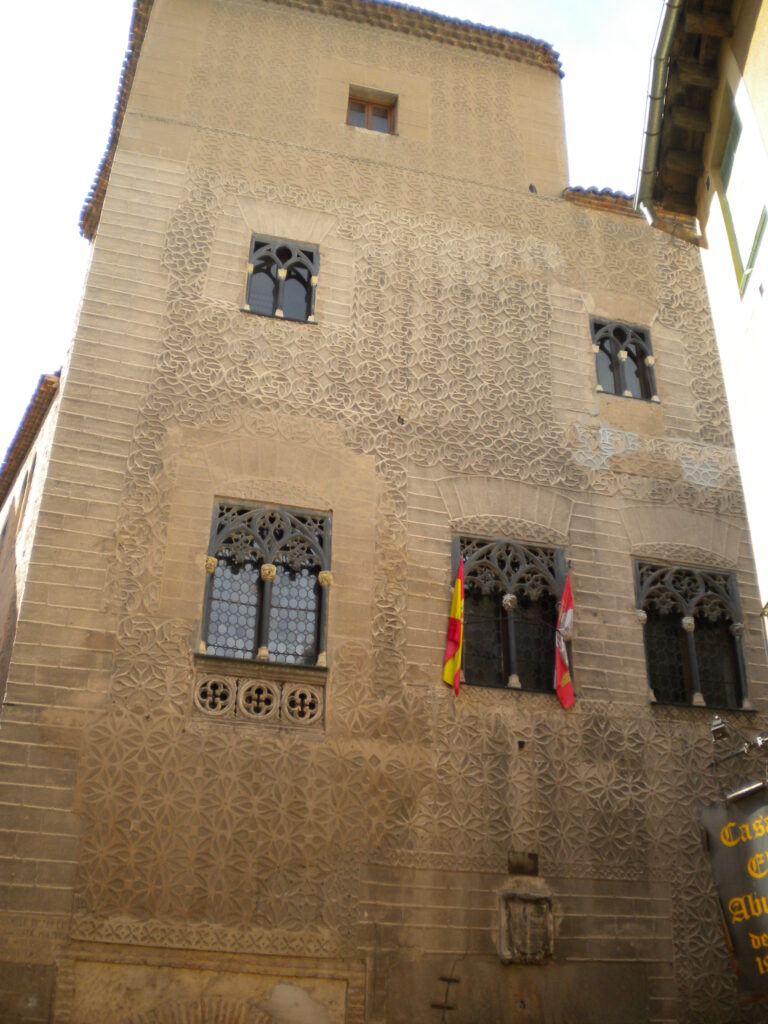
Admire The Palacio Del Conde De Alpuente
Another landmark located in the historic centre, near Plaza Mayor, is the Palacio del Conde de Alpuente. This palace was once the residence of the Count of Alpuente and dates back to the 16th century. Its elegant facade, adorned with intricately carved stone details, exemplifies the era’s architectural style.
Although the palace is not open to the public, its exterior is really worth a quick photo stop.
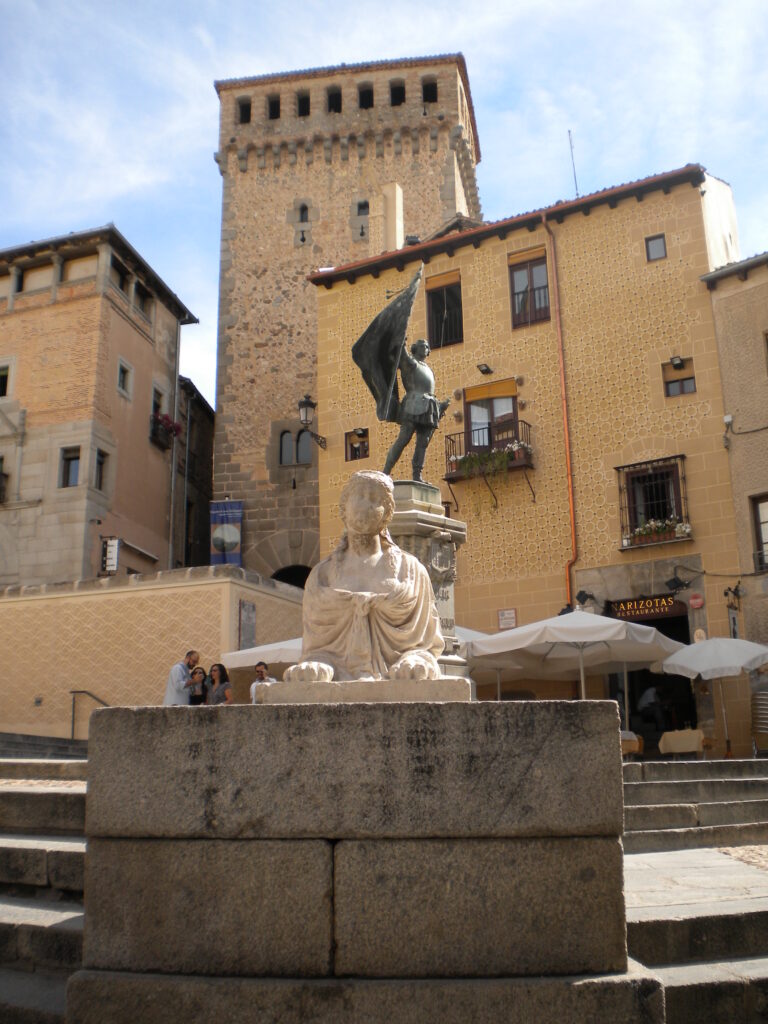
Check Out The Tower of Lozoya
This imposing medieval tower is located at the Plaza de San Martín, one of the most picturesque squares in the city. Built in the late 14th century, the Tower of Lozoya once served as a fortified residence for wealthy nobles.
The tower itself is a mix of Gothic and Mudejar architecture, and today functions as a cultural space for hosting exhibitions and lectures. It’s worth stopping by or finding out before your visit Segovia if there are any events and scheduled that will give you access into the tower.
Visit Segovia’s Many Medieval Churches
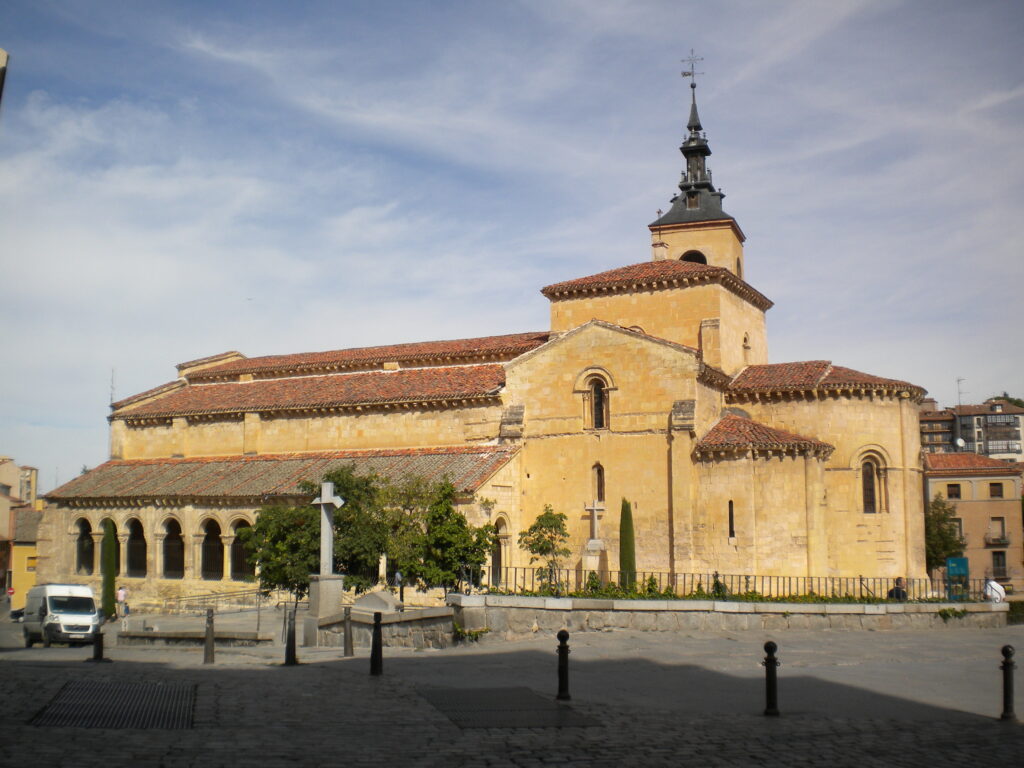
The Church Of San Millán
The Church of San Millán is a remarkable Romanesque structure built in the 12th century. It stands in what was once the Moorish quarter, a district known for its Mozarabic artisans. Its exterior is notable for the Mudéjar bell tower and the porticoes that are characteristic of Segovian Romanesque style.
Inside, the Church has several significant features, including intricately carved capitals on its columns and distinctive horseshoe arches. The church also houses a 14th-century Gothic crucifixion and various important carvings, reflecting its rich historical and artistic heritage. These elements make it a fascinating site for those interested in medieval architecture and religious art.
Tickets & Opening Hours – The Church is open daily from 10am-2pm and 2pm-4:30pm. Entrance is free.
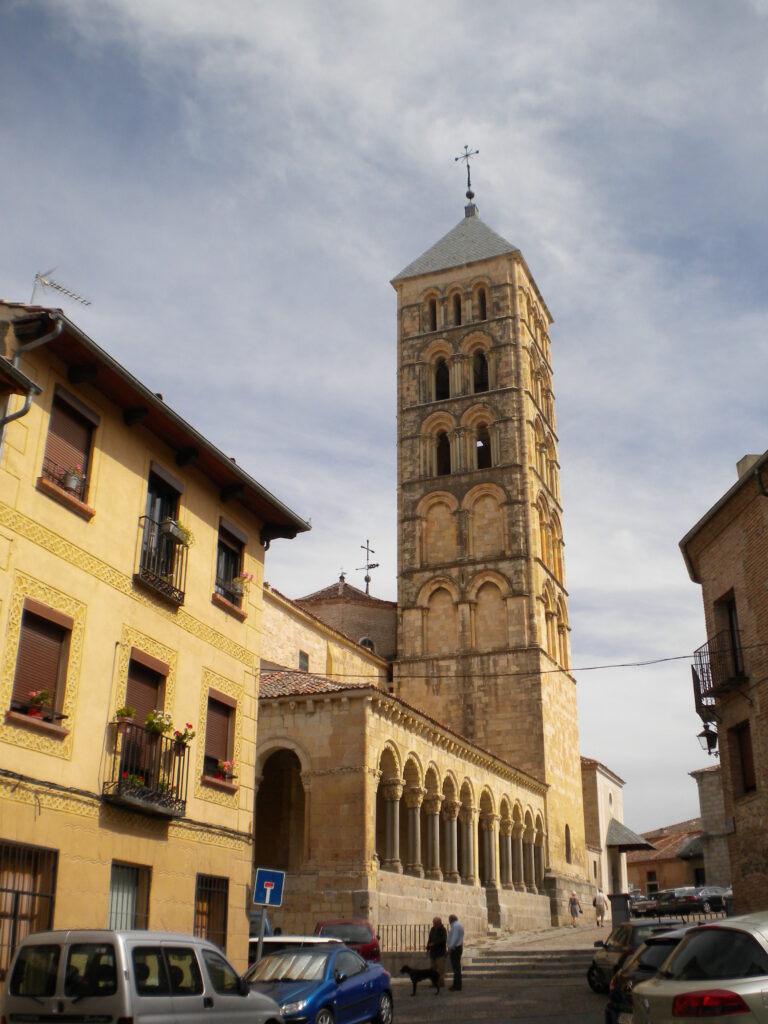
The Church of San Esteban
The Church of San Esteban is another magnificent Romanesque landmark, located near the Plaza Mayor. Dating back to the 12th-century it is instantly recognisable by its stunning bell tower. The church’s exterior exhibits simplicity and elegance, with its robust stone construction highlighting the craftsmanship of the medieval period. Inside, the main altar is adorned with intricate carvings and artistic detailing, is a centrepiece not to be missed. Surrounding it, you’ll find additional altars dedicated to various saints, as well as frescoes and religious paintings.
Opening hours for this Church has recently not been consistent so check ahead in advance to help you plan your visit.
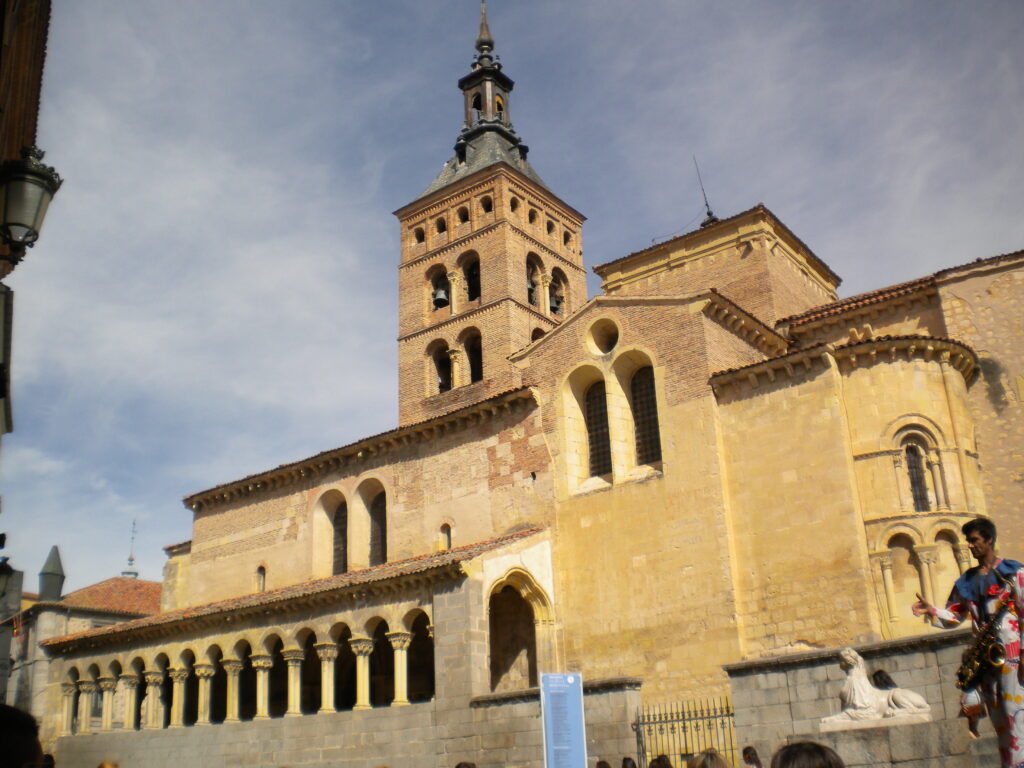
The Church Of San Martin
The Church of San Martín stands as a jewel of Romanesque architecture. Its most captivating feature is the elegant Romanesque atrium that surrounds the building on three sides, an element praised for its harmony and beauty. The rounded arches of the atrium rest gracefully on columns with intricately carved Romanesque capitals, showcasing the craftsmanship of the period.
The opening hours for this church have been inconsistent recently, so check ahead in advance to plan your visit.
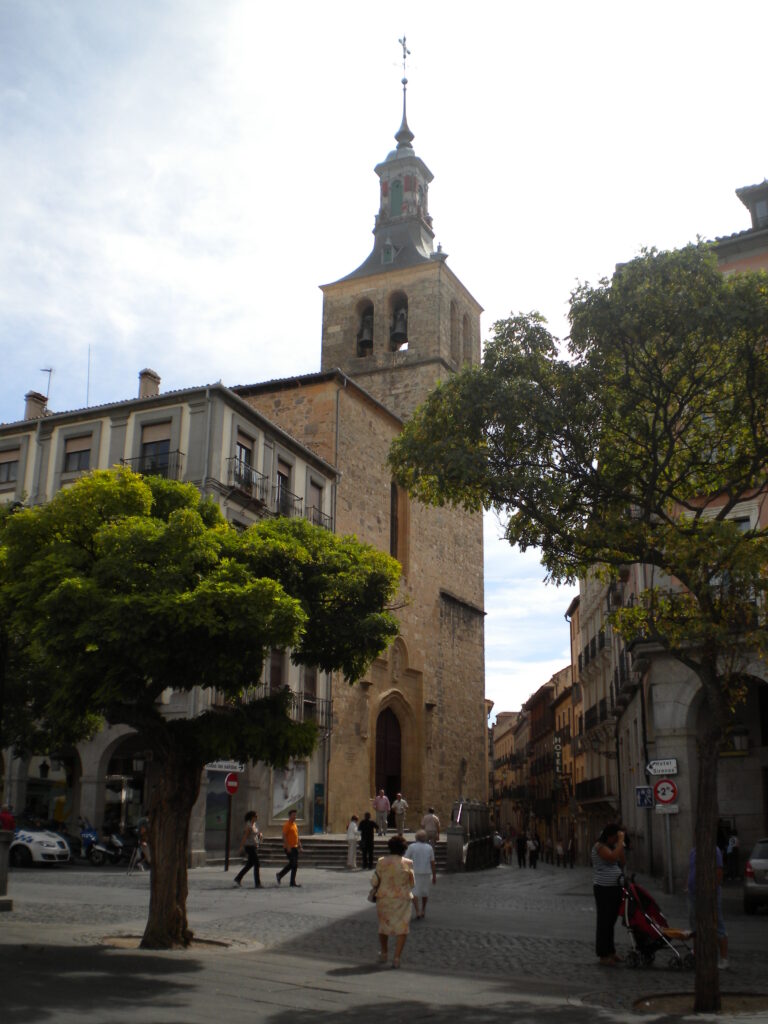
The Church Of San Miguel
The Church of San Miguel, or the Royal Church of San Miguel as it’s often called, is a treasure steeped in history at the heart of Segovia’s Plaza Mayor. Its fascinating past, stunning late-Gothic architecture, and the pivotal role it played in Spain’s history make it an essential stop.
This religious site gained immense historic importance in 1474 when it hosted one of Spain’s most defining moments—the coronation of Queen Isabella I of Castile. This event marked the beginning of her reign, which would eventually lead to the unification of Spain.
The original Romanesque church collapsed in 1532, and the current structure was constructed between 1536 and 1587.
Inside, you’ll find. chapels filled with intricate artistry, but the stars of the show are the funerary monuments. The Rueda Chapel’s alabaster tombs, crafted by Juan Rodríguez’s workshop, are a highlight, as is the 16th-century Chapel of Doctor Laguna. This chapel celebrates the legacy of Andrés Laguna, a Segovian physician, humanist, and court scholar who lived during the Renaissance.
The Church is generally open on Saturdays (12-2pm and 4:30-6:30pm). However, check the latest schedule in advance, as they are subject to change.
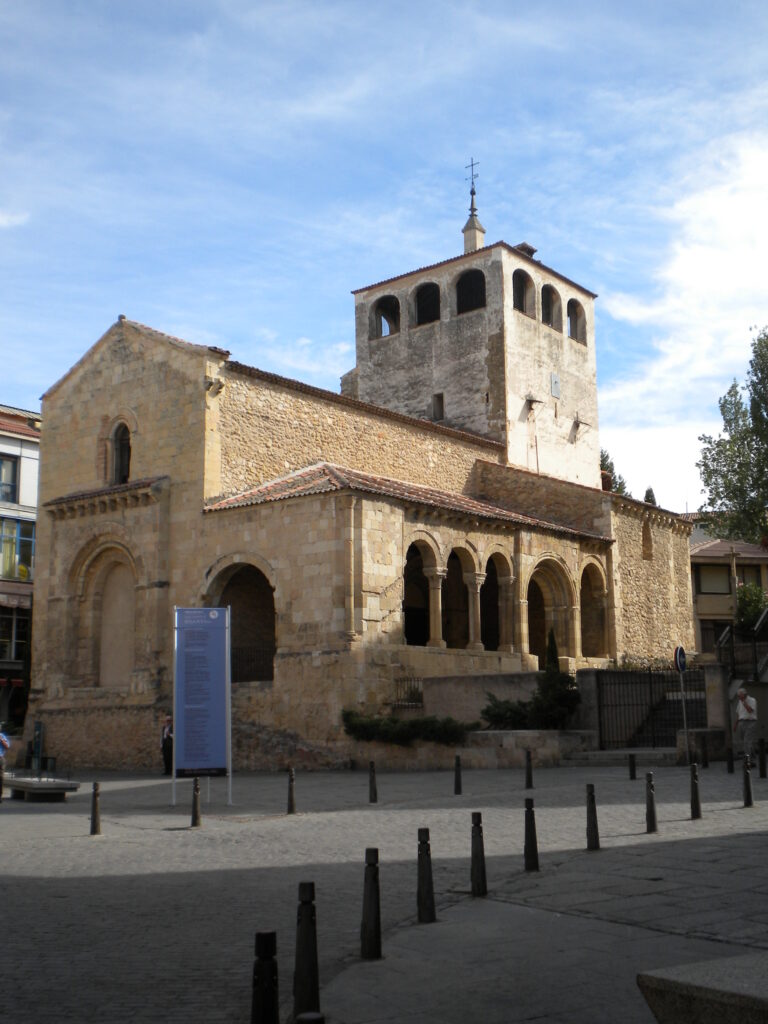
The Church Of San Clemente
The Church of San Clemente is another fascinating Romanesque marvel that takes you back to the 13th century. Located near the impressive Roman Aqueduct on Fernández Ladrida Avenue, this church blends simplicity with intricate design. One of its defining features is its well-preserved Romanesque portico, adorned with intricate arches, delicate carvings, and sculptural accents. A semicircular apse steals the show, with elegant paired arches, columns crowned with ornate capitals, and small round windows that allow light to filter through. These details encapsulate the craftsmanship of medieval builders and their ability to combine function with beauty.
Unfortunately, the Church of San Clemente’s current operating hours are not widely known as it is often shut. That said, it is really worth walking past given its really central location, and admiring from the outside.
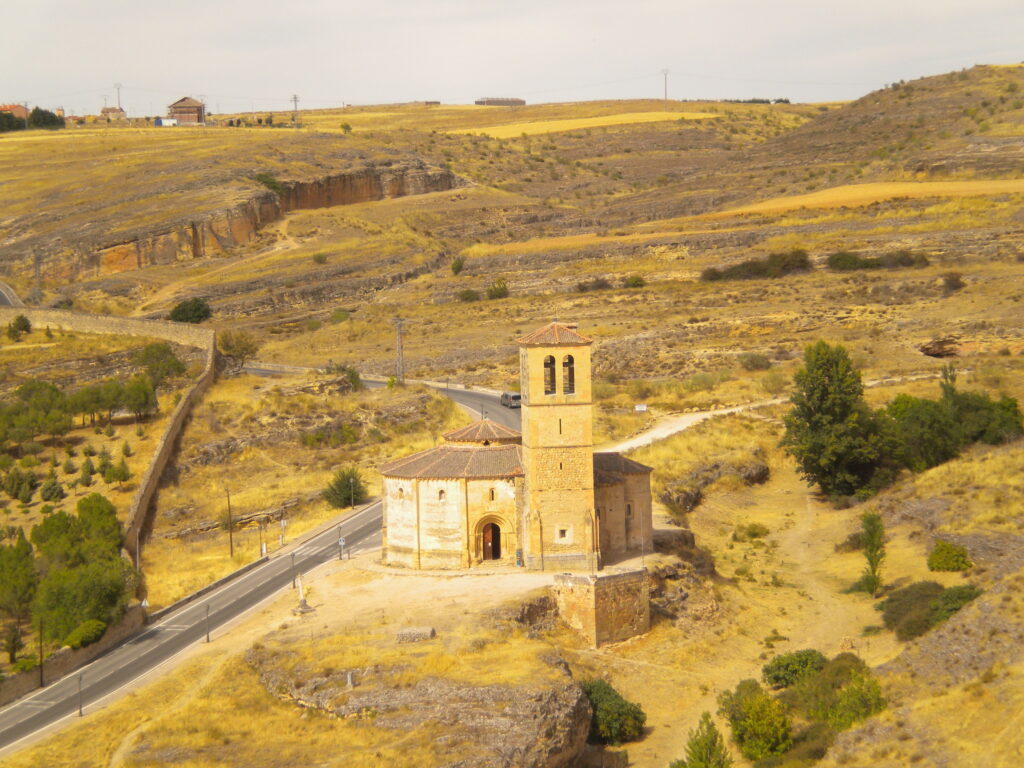
The Church Of The Vera Cruz
The Church of the Vera Cruz, originally known as the Church of the Holy Sepulchre, is a remarkable example of Romanesque architecture. Founded by the Knights Templar in the 13th century, this church is uniquely designed with a 12-sided floor plan, which is quite rare for its time.
The church’s interior is relatively austere, reflecting the Templar’s focus on simplicity and spirituality, but is really worth visiting for it’s historical significance.
This church is not located in the historic city centre, however is still easily reachable by a short drive, taking a local bus or a short walk. The church is open to visitors, but it’s advisable to check the latest opening hours and any special events that might affect accessibility.
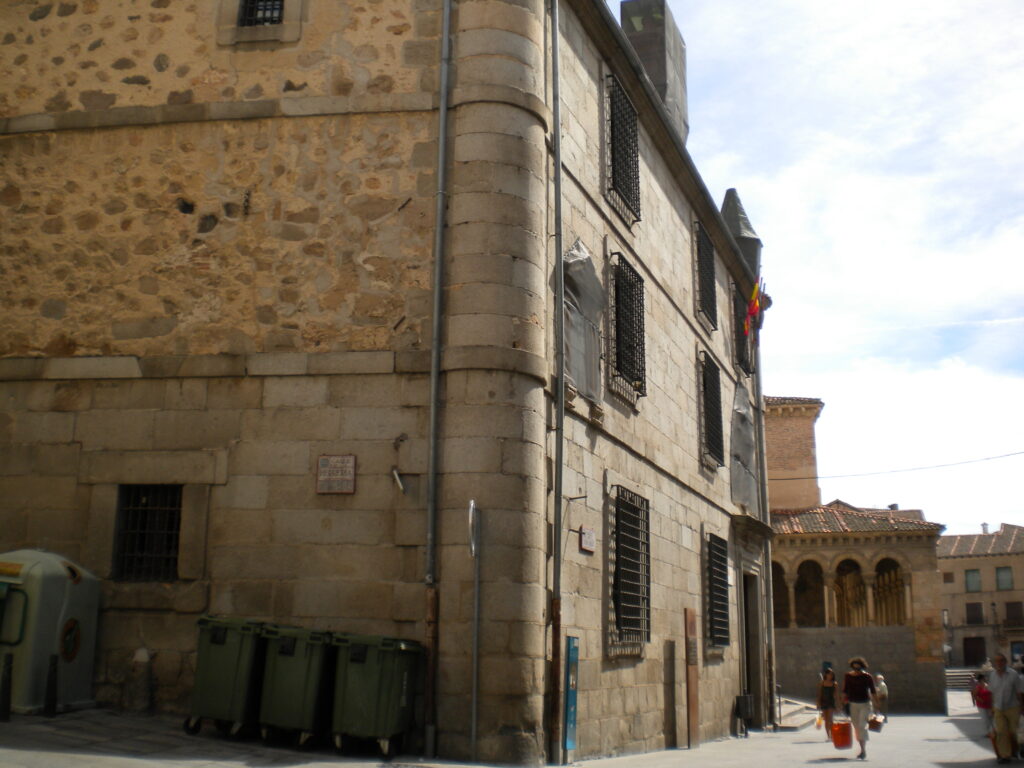
Visit The Prison
Situated in historic centre, this Gothic civil structure was once the backbone of Segovia’s justice system, housing prisoners until the late 19th century. Here you can wander the buildings labyrinth of corridors and dark cells, each echoing stories of survival, rebellion, and even legendary inmates like ‘La Carambada,’ a Robin Hood-like bandit.
You can also climb the Tower of Homage for great views of the city and key landmarks.
Now a cultural venue, the prison frequently hosts exhibitions and events that bring its past to life. The prison is open Tues-Sun and tickets can be purchased at the reception. Exact opening hours differ due to the season and special events, so check ahead in advance to help plan your visit.
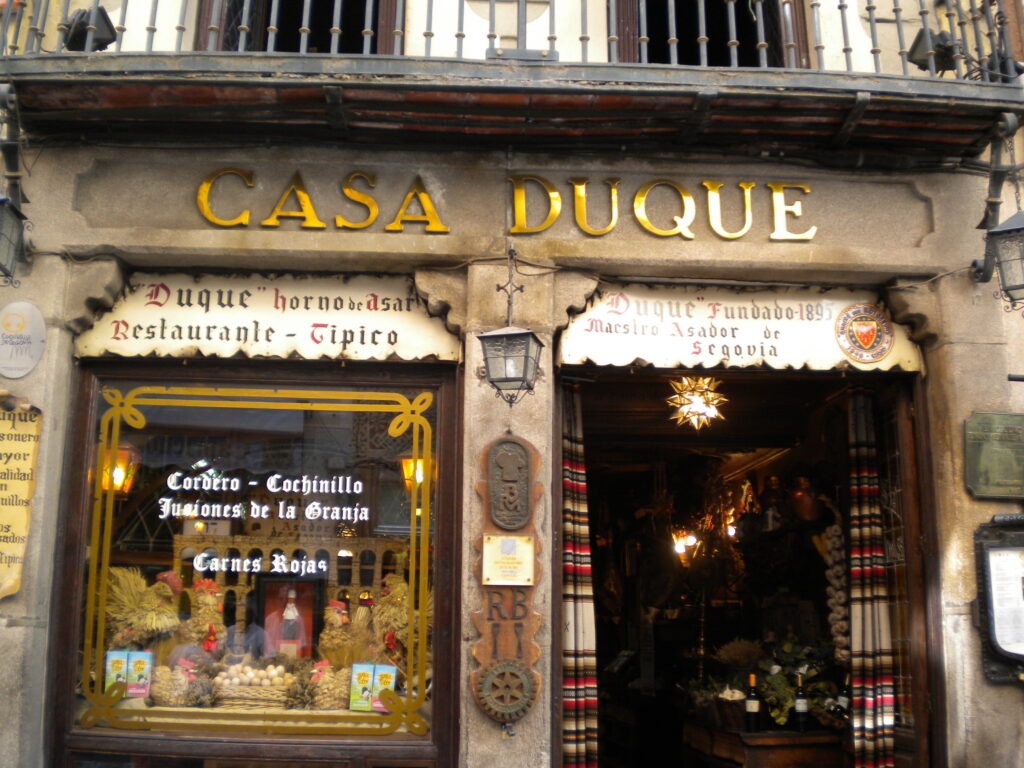
Enjoy The Culinary Scene
Segovia is renowned for its traditional Castilian dishes, many of which have been perfected over centuries and served in some of the most atmospheric restaurants imaginable. Dining in Segovia is not just about the food — it’s a cultural and historical experience, deeply tied to the city’s heritage.
One dish you absolutely must try in Segovia is Cochinillo Asado, or roast suckling pig. A symbol of the city’s gastronomic identity, this dish features tender, flavorful pork with skin so crispy it’s traditionally carved with the edge of a plate. For the best Cochinillo, head to Mesón de Cándido, a historic restaurant located at the foot of the Roman Aqueduct. With over a century of history, this family-run establishment ensures an authentic experience with its rustic decor and dedication to traditional cooking methods.
Another excellent choice is Restaurante José María, renowned for its meticulous preparation of Cochinillo, paired with their exclusive wine, Pago de Carraovejas, which complements the rich flavors of this delicacy.
For lamb lovers, Lechazo is another must-try dish. This roasted lamb is cooked to perfection in traditional wood ovens. It’s tender, succulent, and full of deep, earthy flavors. Mesón Don Jimeno, tucked away in a historic part of the city, is celebrated for its Lechazo, served alongside side dishes that complete this hearty meal.
No meal in Segovia is complete without indulging in Ponche Segoviano for dessert. This iconic cake, created in the city in the early 20th century, is a delightful layering of sponge cake, marzipan, custard, and caramelized sugar. For the most authentic Ponche Segoviano, visit El Alcázar cafe, where the dessert originated, or Limón y Menta, known for its artistry in pastries and desserts.
Beyond the food, dining in Segovia is an immersion into history. Many restaurants are housed in centuries-old buildings with stone walls, wooden beams, and stunning views of landmarks like the Alcázar or the cathedral. For example, Restaurante Duque, one of the oldest eateries in the city, has been serving traditional fare since 1895. Its historic ambiance and dedication to Castilian cuisine make it a popular spot for the locals.
When it comes to drinks, pair your meal with a glass of Ribera del Duero or Rueda wine, both of which are locally produced and highlight the region’s winemaking heritage.
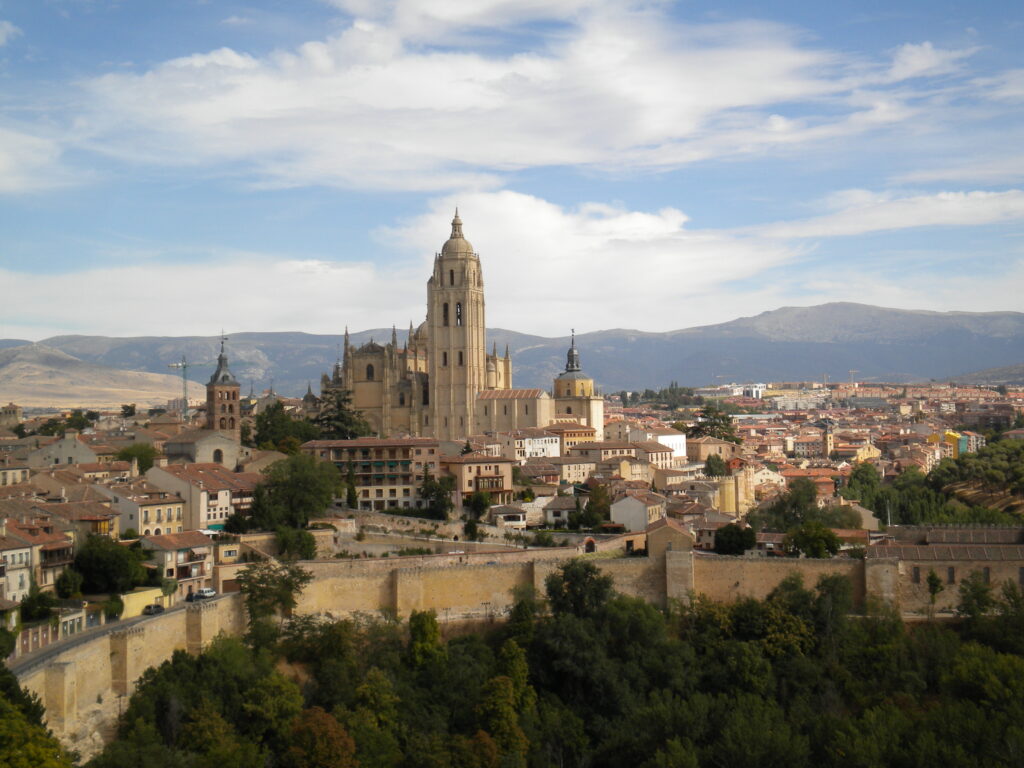
Take In The Incredible Views
Mirador de la Canaleja and Mirador de la Pradera de San Marcos are two scenic viewpoints in Segovia, that offer stunning perspectives of the city’s landscape and architecture.
The Mirador de la Canaleja offers one of the most picturesque views. From this elevated spot, you are treated to sweeping vistas of the terracotta rooftops of Segovia’s old town, with the horizon framed by the rolling Sierra de Guadarrama mountains in the distance.
This mirador (view point) is conveniently located near the heart of the city, making it an easy stop during a stroll through Segovia’s old town.
Meanwhile, Mirador de la Pradera de San Marcos, located below the towering Alcázar, offers a completely different but equally breathtaking perspective. This viewpoint is famous for its postcard-worthy view of the Alcázar perched dramatically on a rocky crag. From here, the fortress appears as if it’s straight out of a storybook, with its fairytale turrets and spires, surrounded by lush greenery.
Discover The Royal Mint Of Segovia
A lesser-known attraction, the Royal Mint of Segovia (Casa de la Moneda), offers a fascinating glimpse into Spain’s industrial and monetary history. Located on the left bank of the Eresma River, this historic site was originally established in the late 16th century by architect Juan de Herrera under the commission of King Philip II. It was the first mechanised factory in Spain, utilizing advanced rolling and coining techniques with hydraulic wheels, a technology brought to Spain by Archduke Ferdinand of Tyrol.
The mint played a crucial role in the production of currency until its closure in 1968. After a period of disrepair, it underwent extensive rehabilitation from 2007 to 2011 and today is it a museum showcasing the history of coinage and industrial heritage.
Location & Opening Hours: The Royal Mint is open from Wed-Sat from 10am-2pm and then 4pm-6pm. Sunday opening hours are 10am-2pm. There is an admission fee and tickets can be purchased at the reception.
The location is just a short distance from the city centre; about a 10 minute walk. A local bus services are also available, such as Bus 9 from the Aqueduct.
Wander The Royal Palace Of La Granja
A short drive from Segovia will take you to the Royal Palace of La Granja de San Ildefonso, an 18th-century summer residence for Spanish royalty. While the Baroque palace itself is impressive, the real highlight is its expansive gardens, inspired by the grandeur of Versailles.
Stroll through tree-lined alleys, past ornate fountains, and find quiet spots to admire the beautifully manicured greenery. Don’t miss the Fountain of Neptune and the Fountain of Fame, which operate on special days when water displays are held. This serene retreat is an excellent place to relax and escape the bustle of the city.
The palace itself features neoclassical architecture with baroque influences. Inside, you can explore opulent rooms filled with period furnishings, tapestries, and artworks that reflect the grandeur of the Spanish monarchy. The palace also houses a collection of tapestries, which are considered some of the finest in the world.
The Royal Palace of La Granja is open Tues-Sun. During the winter months (Oct-Mar), it is open from 10am-6pm, and in the summer (Apr-Sep) form 10am-7pm.
The palace is closed on Mondays and on specific bank holidays. There is a general admission cost and tickets can be purchased onsite.
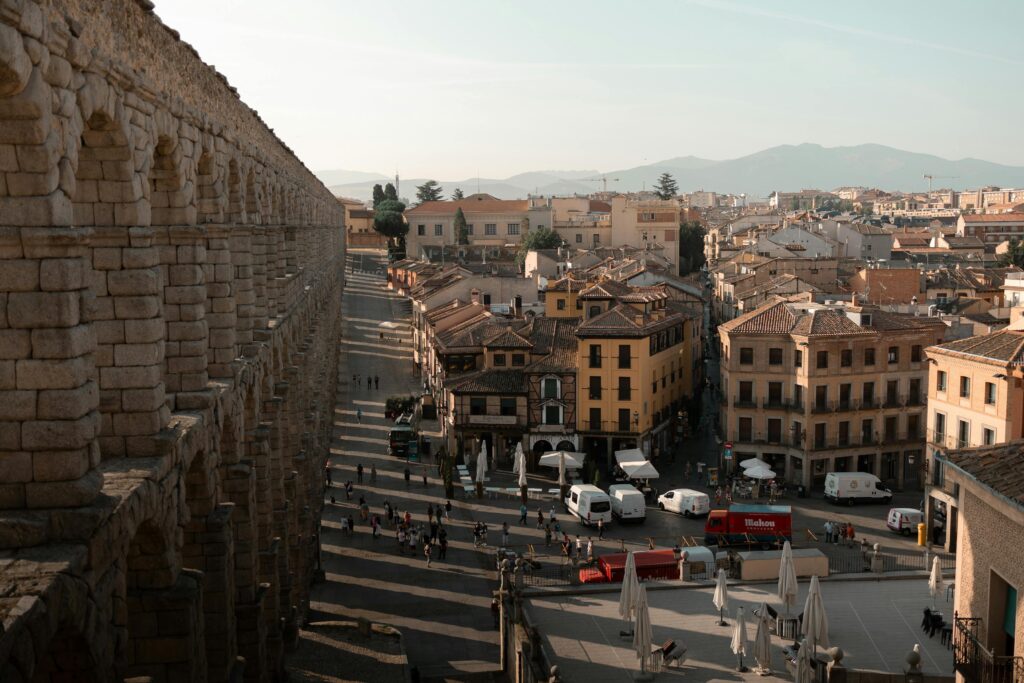
So To Wrap Up On The Best Things To See & Do In Segovia…
From its ancient Roman aqueduct and fairytale castle to its quiet Jewish Quarter and hidden historical gems, every corner tells a story. Whether you’re climbing castle towers, savoring mouthwatering cuisine, or simply wandering its enchanting streets, Segovia offers a rich and unforgettable experience for every traveler. Pack comfortable shoes and an eye for history, and get ready to fall in love with this magical Spanish city!
Want to visit another fabulous city in Spain. Red my blog on Salamanca, if you want to know about the best things to do in Spain’s University city.
Further FAQs
Is There A Tourist Pass Available When Visiting Segovia
Purchasing one of Toledo’s city tourist passes is a smart way to save money; especially if you are planing on visiting several attractions. Yes, there is a tourist pass available for Segovia. The Segovia Tourist Pass can be purchased for a small fee and offers discounts and free tickets to various attractions, hotels, and more. You can buy it online or at the city’s Visitor Centre.
How To Get To Toledo
Segovia is nestled in the heart of Spain’s Castile and León and just over 90 kilometres northwest of Madrid. Getting to Segovia is easy and convenient, with several transport options to suit.
By Train – If you’re in Madrid, the fastest and most popular way to reach Segovia is by taking the high-speed AVE train. This train covers the roughly 90-kilometre distance in just about 30 minutes, bringing you to the Segovia-Guiomar Station, located a short bus or taxi ride from the city center. Alternatively, there are slower regional trains that are more budget-friendly but take closer to two hours. For those seeking a cost-effective option, buses operated by companies like Avanza depart regularly from Madrid’s Moncloa station. The bus ride takes about an hour and 20 minutes and drops you off near the historic center, making it a convenient choice for day-trippers.
By Bus – For those seeking a cost-effective option, buses operated by companies like Avanza depart regularly from Madrid’s. The bus ride takes about an hour and 20 minutes and drops you off near the historic centre, making it a convenient choice for day-trippers.
By Car – If you prefer to drive, Segovia is well-connected by major highways. From Madrid, take the AP-6 toll highway, which links with the AP-61 to Segovia; the trip typically takes about an hour. Parking is available on the outskirts of the city, and a shuttle bus can bring you into the historic area, as driving through the old town is restricted.
To note, Segovia does not have its own airport, so the closest airport is Adolfo Suárez Madrid-Barajas Airport.
When To Go To Segovia
The best time to visit Segovia depends on what kind of experience you’re looking for, but spring (April to June) and early fall (September to October) are the most popular seasons.
During these months, the weather is pleasantly mild, with temperatures ranging from 15°C to 25°C (59°F to 77°F), making it ideal for exploring the city’s landmarks. The crowds are moderate compared to the peak summer season, allowing you to enjoy the historic streets and squares at a more relaxed pace. If you visit in June, you can catch the famous Festival de Segovia, an event showcasing classical music and dance performances in stunning venues across the city. Springtime also fills the surrounding countryside with vibrant colors, offering beautiful backdrops for sightseeing.
Summer (July to August) brings warmer temperatures, often reaching 30°C (86°F), and the highest influx of tourists. While this makes the city lively, it can feel crowded, especially around major attractions. However, summer also brings a festive atmosphere, with outdoor performances and events like La Noche de San Juan, a magical midsummer celebration with bonfires and music.
For those seeking a quieter and cooler experience, winter (December to February) is ideal. The weather is colder, averaging between 0°C and 10°C (32°F to 50°F), but the city feels peaceful, and popular attractions are less crowded. December transforms Segovia into a festive wonderland with Christmas markets and decorations adorning the Plaza Mayor.
How Much Time To Spend In Segovia
For those short on time, a day trip from Madrid is perfect to cover the city’s must-see landmarks. You can start by marvelling at the Roman Aqueduct, one of Spain’s most iconic ancient structures, then stroll along Calle Real to reach Plaza Mayor. From there, visit the Segovia Cathedral and the fairytale-like Alcázar, which offers stunning panoramic views from its tower.
If you have a weekend or two days to spare, you can explore Segovia at a more relaxed pace and discover its hidden gems. Aside from the major attractions, you can wander through the Jewish Quarter, visit Casa de los Picos with its fascinating facade, and enjoy a meal of traditional cochinillo (suckling pig) at one of the many renowned local restaurants. With extra time, consider a short hike to the Mirador de la Pradera de San Marcos for a breathtaking view of the Alcázar from below. For history buffs or art enthusiasts, a couple of days also allows for visits to smaller museums, churches, and exhibitions.
Where To Stay In Segovia
Segovia offers a range of accommodations perfect for every budget and travel style. For a touch of history, consider lodging at Hotel Infanta Isabel, a charming boutique hotel set in a centuries-old building right in Plaza Mayor, offering stunning views of the cathedral. If you are looking for luxury you will for sure enjoy Eurostars Convento Capuchinos, a former monastery turned five-star hotel where history meets elegance, located near the Alcázar.
For budget-friendly stays, Hostal Don Jaime II is a cozy option close to the iconic Roman Aqueduct, ensuring easy access to the city’s top attractions.
For some great tips on booking hotel rooms, read the The Ultimate Guide To Booking Hotel Rooms blog post.

